Peep show
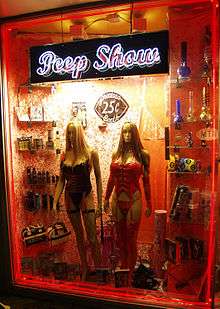
A peep show or peepshow is an exhibition of pictures, objects or people viewed through a small hole or magnifying glass. Though historically a peep show was a form of entertainment provided by wandering showmen, nowadays it more commonly refers to a presentation of a sex show or pornographic film which is viewed through a viewing slot. Historically the peep hole was intended to control the point of view to allow an illusion of depth perception, while showmen would later use it to charge for access to the view. For sex shows it also became a means to view material that would be objected to if freely displayed.
History
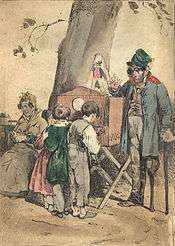
Peep shows,[1] also known as peep box or raree show ("rarity show") can be traced back to the early modern period (15th century in Europe) and are known in various cultures. Around 1437 Italian humanist author, artist, architect, poet, priest, linguist, philosopher and cryptographer Leon Battista Alberti is thought to have created the earliest impressive peep show boxes with painted pictures to be viewed through a small hole. He had two kinds: night scenes with the moon and stars, and day scenes. It is thought these pictures may have been transparent and lit from behind, possibly changing from day to night by changing the lighting. It has also been suggested that it may have been a predecessor of the magic lantern that could project images.[2][3]
In the 17th and 18th century peep shows were exhibited on streets and fairs across Europe by itinerant showmen, competing with other entertainment like dancing bears, jugglers, conjurers, et cetera.[4] Their wooden cabinets could have several viewing holes and contain sets of pictures to be set into a viewing position by pulling a corresponding string. The show was accompanied by spoken recitation that explained or dramatized what was happening inside. The boxes were often decorated inside to resemble theatrical scenes.
Peep shows were most popular in the 17th century in Holland.[5] Some artists from the 17th-century Dutch Golden Age painting, like Pieter Janssens Elinga and Samuel Dirksz van Hoogstraten created a type of peep shows with an illusion of depth perception by manipulating the perspective of the view seen inside, usually the interior of a room. From around 1700 many of these "perspective boxes" or "optica" had a bi-convex lens with a large diameter and small dioptre for an exaggerated perspective, giving a stronger illusion of depth. Most pictures showed architectural and topographical subjects with linear perspectives.[6][7] From around 1745 similar perspective view prints became very popular for the zograscope, which used the same principle with the lens on a stand rather than in a box. Peep shows were further developed with translucent painting techniques, perforations and cut-out shapes that provided special effects when lit from behind by candles. Changing the light from the front to the back of the picture could change the scene from day to night, much like the dissolving views that would later become a popular type of magic lantern show.[6]
In the early 18th century the perspective boxes were very appreciated in Japan, where they were referred to as Holland machines.[4] They may have been imported from China earlier than from The Netherlands.[8]
19th-century Chinese peep shows were known by many names including la yang p'ien (Chinese: 拉洋片; pinyin: lā yáng piān; literally: "pulling foreign picture cards"). Sometimes the showman would perform for a crowd with puppets or pictures outside the box and then charge people extra to look through the holes. In Ottoman Syria a form of peep show called sanduk al-ajayib ("wonder box") existed, which the storyteller carried on his back. The box had six holes through which people could see scenes backlit by a central candle. Sanduk al-ajayib stories were about contemporary figures and events, or showed scenes of heaven and hell.[9]
Other common subjects in peep shows throughout the world have been exotic views and animals, scenes of classical drama or masques, court ceremonies, surprise transformations (e.g., of an angel into a devil) and of course, lewd pictures.
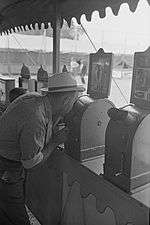
Raree shows were precursors of toy theatres, with movable scenes and paper figurines, popular in the 19th century. They can also be seen as predecessors to optical toys like Chinese fireworks, the diorama, the stereoscope and the magic lantern.[3]
Some peep shows offer the only accurate representation of the stage design and scenery of the masques and pageants of their time.[3]
Pornographic shows
Peep shows have been used for erotic and pornographic pictures, such as What the Butler Saw, since before the turn of the twentieth century.
In contemporary use, a peep show is a piecewise presentation of pornographic films or a live sex show which is viewed through a viewing slot, which shuts after the time paid for has expired. The viewing slots can be operated by a money box device, or paid for at a counter.
For live peep shows, booths can surround a stage upon which usually a female performer performs a striptease and sexually explicit poses. In Barcelona female performers at times also perform sexual intercourse with male performers on stage. In some cases, booths include paper towel dispensers,[10] for customers who engage in masturbation. A customer and performer can mutually agree on a fee for a "private dance", which can take place in a peep show booth with a clear window and seating space for only one spectator.
California
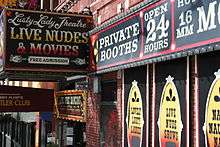
Research on peep show establishments in California[11] examined the hypothesis that neighborhoods surrounding sex businesses such as peep show establishments and X-rated movie stores have higher rates of crime. The researchers compared 911 calls in peep show and control neighborhoods in San Diego. Although peep show neighborhoods had approximately 16 percent more calls, the researchers concluded that the difference was not statistically significant. Other researchers reanalyzed the data and concluded that the difference was significant.[12]
Regal Show World
Regal Show World was an adult entertainment business on lower Market Street in San Francisco, California.[13] The company's slogan was "Where you are king".[14] The business had a peep show and an adult video arcade.[13][15][16] The peep show had performers working in an enclosed round room with viewing booths surrounding it and sometimes had a "double in the bubble" show in which two performers worked simultaneously.[14] During the winter of 1997 to 1998, the business had thirty-five performers.[13] At this time, over 80% of performers there attempted to unionize and "signed union authorization cards for representation by the Service Employees International Union (SEIU), Local 790".[13]
The business was owned by Bijou Group, Inc., a privately held company in San Francisco that was founded in 1990.[17][18] Bijou Group owned similar businesses in San Francisco such as New Century Theater, Market Street Cinema, and the Campus Theater.[13][19] Bijou Group, Inc. filed for Chapter 11 bankruptcy reorganization circa 1994.[19] In November 1998, management of Regal Show World announced that the peep show would be closed on November 30th of that month due to "economic reasons".[13] At the time, some performers in the industry stated that closure of the peep show was done as a retaliative measure against attempts for performers to unionize.[13] The company declared bankruptcy after performers made a second attempt at unionization, whereby the performers "signed cards calling for a union election", and the theater was closed.[20]
Washington
The former Lusty Lady peep show in San Francisco, California, entered the news in 1997, when it became the first U.S. sex business to be unionized. In 2003 it was bought by the employees and became a worker cooperative.
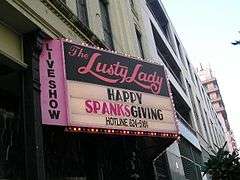 The marquee for the Lusty Lady peep show in Seattle
The marquee for the Lusty Lady peep show in Seattle
See also
References
- ↑ Thomas Weynants, "From the Rarekiek, 17th. & 18th. Century optical entertainment, to the birth of Television"
- ↑ "Camera Obscura - Encyclopedia".
- 1 2 3 "Peep show - children's toy". britannica.com.
- 1 2 Balzer, Richard. "Dick Balzer's Website: Peepshows". www.dickbalzer.com.
- ↑ "Peep-show box - Oxford Reference". oxfordreference.com. doi:10.1093/oi/authority.20110803100313907.
- 1 2 "Peepshow". visual-media.eu.
- ↑ Wagenaar; Duller; Wagenaar-Fischer. Dutch Perspectives.
- ↑ "Full text of "Toward A Student Based Approach To Translation Teaching"". archive.org.
- ↑
- Mair, Victor H. Painting and Performance: Chinese Picture Recitation and its Indian Genesis. Honolulu: University of Hawaii Press, 1988.
- ↑ Jon Griffin Donlon, "Peep Shows," St. James Encyclopedia of Pop Culture. According to Dr. Elliot Chiu, "At first, small booths with a seat, a lock, and a roll of paper towels were made available for individual viewing of 8 or 16 mm stag loops or for access to a usually circular 'stage' with living performers."
- ↑ Daniel Linz, Bryant Paul, and Mike Z. Yao, "Peep show establishments, police activity, public place, and time: A study of secondary effects in San Diego, California", The Journal of Sex Research, May 1, 2006.
- ↑ Richard McCleary and James W. Meeker, "Do peep shows 'cause' crime?", The Journal of Sex Research, May 1, 2006.
- 1 2 3 4 5 6 7 "Exotic Dancer's Alliance - Winter 1997–1998". Retrieved 14 April 2015.
- 1 2 "Live Nerd Girls". 2007. Archived from the original on 14 June 2016. Retrieved 14 April 2015.
- ↑ Davidson, G. (2012). Queer Commodities: Contemporary US Fiction, Consumer Capitalism, and Gay and Lesbian Subcultures. American Literature Readings in the Twenty-First Century. Palgrave Macmillan. p. 159. ISBN 978-1-137-01123-7.
- ↑ "Spectator. The Voice of Erotic San Francisco Vol. 33, No. 1; Issue 834, September 23-29". Alta-glamour.com. Retrieved April 14, 2015.
- ↑ "Bijou Group Inc". Manta.com. Retrieved 14 April 2015.
- ↑ "Bijou Group Inc". Findthecompany.com. Retrieved 14 April 2015.
- 1 2 "Erotic Dancers Receive Cash Judgments for Wages in Oregon and San Francisco; Mitchell Brothers Next?". November 17, 1995. Retrieved April 14, 2015.
- ↑ Dank, B.B.M.; Roberto Refinetti, P.D. The Politics of Sexuality. Sexuality and Culture. Transaction Publishers. p. 65. ISBN 978-1-4128-3142-0.
Further reading
- Dank, B.B.M.; Roberto Refinetti, P.D. The Politics of Sexuality. Sexuality and Culture. Transaction Publishers. pp. 41–43. ISBN 978-1-4128-3142-0.
- Blee, K.M.; Twine, F.W. (2001). Feminism and Antiracism: International Struggles for Justice. NYU Press. p. 61. ISBN 978-0-8147-9855-3.
Regal Show World
- "E.D.A. GENERAL INFORMATION - Summer-Fall 1997". Issue #9. Exotic Dancer's Alliance. Retrieved 14 April 2015.
- "Southern Poetry Review". Volumes 37-38. Southern Poetry Review. 1998. p. 69.
External links
| Wikimedia Commons has media related to Peep shows. |
- The Peep Show and Toy Theatre (many museum pieces)
- The Sunday Times Article about a sex workers co-op at Soho UK peep show, July 14, 1985
- Ashley West (June 29, 2014). "Marty Hodas: King of the Peeps" ( audio interview). The Rialto Report.